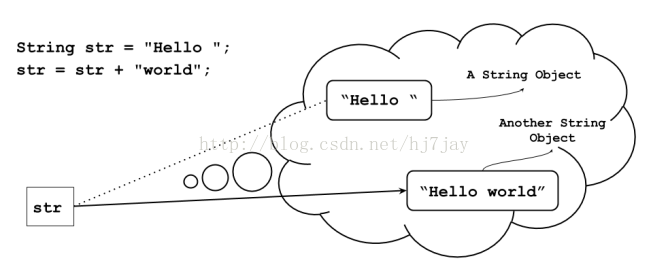您好,登錄后才能下訂單哦!
您好,登錄后才能下訂單哦!
前言
在Java開發者中,字符串的拼接占用資源高往往是熱議的話題.
讓我們深入討論一下為什么會占用高資源。
在Java中,字符串對象是不可變的,意思是它一旦創建,你就無法再改變它。所以在我們拼接字符串的時候,創建了一個新的字符串,舊的被垃圾回收器所標記。

如果我們處理上百萬的字符串,然后,我們就會生成百萬的額外字符串被垃圾回收器處理。
在大多數的教程中,也許你會看到用+號拼接字符串會生成多個String,導致性能過差,建議使用StringBuffer/StringBuilder來拼接。
可是真的是這樣的嗎?
本文在JDK8中做了如下實驗:
public static void main(String[] args) {
String result = "";
result += "some more data";
System.out.println(result);
}
通過javap -c來反編譯得到:
Code:
0: aload_0 // Push 'this' on to the stack
1: invokespecial #1 // Invoke Object class constructor
// pop 'this' ref from the stack
4: return // Return from constructor
public static void main(java.lang.String[]);
Code:
0: ldc #2 // Load constant #2 on to the stack
2: astore_1 // Create local var from stack (pop #2)
3: new #3 // Push new StringBuilder ref on stack
6: dup // Duplicate value on top of the stack
7: invokespecial #4 // Invoke StringBuilder constructor
// pop object reference
10: aload_1 // Push local variable containing #2
11: invokevirtual #5 // Invoke method StringBuilder.append()
// pop obj reference + parameter
// push result (StringBuilder ref)
14: ldc #6 // Push "some more data" on the stack
16: invokevirtual #5 // Invoke StringBuilder.append
// pop twice, push result
19: invokevirtual #7 // Invoke StringBuilder.toString:();
22: astore_1 // Create local var from stack (pop #6)
23: getstatic #8 // Push value System.out:PrintStream
26: aload_1 // Push local variable containing #6
27: invokevirtual #9 // Invoke method PrintStream.println()
// pop twice (object ref + parameter)
30: return // Return void from method
可以看到Java編譯器優化了生成的字節碼,自動創建了一個StringBuilder,并進行append操作。
由于構建最終字符串的子字符串在編譯時已經已知了,在這種情況下Java編譯器才會進行如上的優化。這種優化稱為a static string concatenation optimization,自JDK5時就開始啟用。
那是否就能說明在JDK5以后,我們不再需要手動生成StringBuilder,通過+號也能達到同樣的性能?
我們嘗試下動態拼接字符串:
動態拼接字符串指的是僅在運行時才知道最終字符串的子字符串。比如在循環中增加字符串:
public static void main(String[] args) {
String result = "";
for (int i = 0; i < 10; i++) {
result += "some more data";
}
System.out.println(result);
}
同樣反編譯:
Code:
0: aload_0 // Push 'this' on to the stack
1: invokespecial #1 // Invoke Object class constructor
// pop 'this' ref from the stack
4: return // Return from constructor
public static void main(java.lang.String[]);
Code:
0: ldc #2 // Load constant #2 on to the stack
2: astore_1 // Create local var from stack, pop #2
3: iconst_0 // Push value 0 onto the stack
4: istore_2 // Pop value and store it in local var
5: iload_2 // Push local var 2 on to the stack
6: i2d // Convert int to double on
// top of stack (pop + push)
7: ldc2_w #3 // Push constant 10e6 on to the stack
10: dcmpg // Compare two doubles on top of stack
// pop twice, push result: -1, 0 or 1
11: ifge 40 // if value on top of stack is greater
// than or equal to 0 (pop once)
// branch to instruction at code 40
14: new #5 // Push new StringBuilder ref on stack
17: dup // Duplicate value on top of the stack
18: invokespecial #6 // Invoke StringBuilder constructor
// pop object reference
21: aload_1 // Push local var 1 (empty String)
// on to the stack
22: invokevirtual #7 // Invoke StringBuilder.append
// pop obj ref + param, push result
25: ldc #8 // Push "some more data" on the stack
27: invokevirtual #7 // Invoke StringBuilder.append
// pop obj ref + param, push result
30: invokevirtual #9 // Invoke StringBuilder.toString
// pop object reference
33: astore_1 // Create local var from stack (pop)
34: iinc 2, 1 // Increment local variable 2 by 1
37: goto 5 // Move to instruction at code 5
40: getstatic #10 // Push value System.out:PrintStream
43: aload_1 // Push local var 1 (result String)
44: invokevirtual #11 // Invoke method PrintStream.println()
// pop twice (object ref + parameter)
47: return // Return void from method
可以看到在14的時候new了StringBuilder,但是在37的時候goto到了5,在循環過程中,并沒有達到最優化,不斷在生成新的StringBuilder。
所以上述代碼類似:
String result = "";
for (int i = 0; i < 10; i++) {
StringBuilder tmp = new StringBuilder();
tmp.append(result);
tmp.append("some more data");
result = tmp.toString();
}
System.out.println(result);
可以看到不斷生成新的StringBuilder,并且通過tostring,原來的StringBuilder將不再引用,作為垃圾,也增加了GC成本。
所以,在實際的使用中,當你無法區分字符串是靜態拼接還是動態拼接的時候,還是使用StringBuilder吧。
Reference:
http://www.pellegrino.link/2015/08/22/string-concatenation-with-java-8.html
總結
以上就是這篇文章的全部內容了,希望本文的內容對大家的學習或者工作具有一定的參考學習價值,如果有疑問大家可以留言交流,謝謝大家對億速云的支持。
免責聲明:本站發布的內容(圖片、視頻和文字)以原創、轉載和分享為主,文章觀點不代表本網站立場,如果涉及侵權請聯系站長郵箱:is@yisu.com進行舉報,并提供相關證據,一經查實,將立刻刪除涉嫌侵權內容。